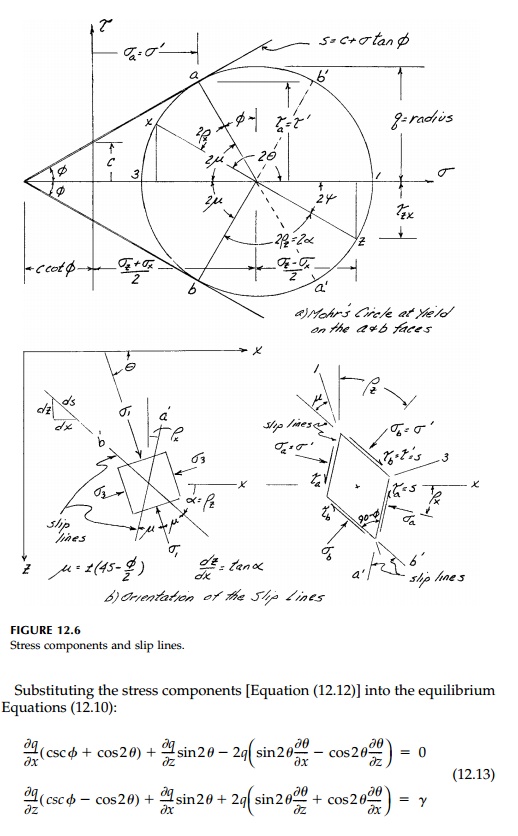Chapter: Civil : Principles of Solid Mechanics : Slip Line Analysis
Slip Line Theory
SlipLine Theory
Only at points where we
know the orientation of the principal stresses do we know the orientation of
the slip surface to be +- (45 + ŽĢ/2)
to the direction of Žā1.
We often know the principal orientation at boundaries, but seldom anywhere
else. As the stresses change throughout the field in some fashion so do the isoclinics
and the slip surface must, therefore, in general be curved.
To determine the shape or characteristic of the slipline
field we must solve the basic equations in terms of geometric parameters.
Rewriting the MohrCoulomb criterion in terms of a general stress state:

where, from Figure 12.6a each of the two terms
equals the radius of MohrŌĆÖs Circle, q. We also have the equilibrium
equations:

where the unit weight is assumed to be the only body
force.
It would appear that with three equations,
[Equations (12.9), (12.10a), and (12.10b)], the determination of the three
unknown stress components is determinate. However, this is not really true
since the yield Equation (12.9) is only true on the slip surfaces for which we
do not know the shape or critical location.
The two slip lines (or characteristic lines) are
inclined at an angle  to the direction of the maximum principal
compressive stress Žā1. Since MohrŌĆÖs Circle gives the orientation of the
normal to the surface on which the stresses act, the orientation of the surface
itself is at 90┬ o or 180┬ o on MohrŌĆÖs Circle. From Figure 12.6b, the equations for
the slip lines are then:
to the direction of the maximum principal
compressive stress Žā1. Since MohrŌĆÖs Circle gives the orientation of the
normal to the surface on which the stresses act, the orientation of the surface
itself is at 90┬ o or 180┬ o on MohrŌĆÖs Circle. From Figure 12.6b, the equations for
the slip lines are then:

and the stress components producing potential slip are expressed in terms of the invariant q and the isoclinic angle ╬Ė.

and, from the definition of a total derivative,
trigonometric identities, and Equation (12.11), these can be reduced to

This equation, obtained by K├Čtter in 1888 expresses,
in differential form, the variation of the critical stress state, q, on
the slip surface as the orientation ╬▒ of the slip surface
changes. It can be written in terms of the various components of the critical
state which may be useful in different cases. On the slip planes where MohrŌĆÖs
Circle touches the failure envelope:

which is the version often used for integration
along a slip line.
Various combinations of
the three material properties used to characterize yield of a MohrCoulomb
material are summarized in Table 12.1. If we assume a yield plateau and thus
eliminate strain effects, these properties will not change as the yield area
spreads to form a collapse mechanism (the slip surface) at the limit load.
In the next sections we
will discuss a few simple cases where Equation (12.14) can be integrated. With
the stress boundary conditions, it may be possible then to determine the shape
of the critical slip surface and the stresses on the slip surface at collapse.
Solutions for difficult boundary loads and for the general case where ŽĢ,
c, or Žł are not neglected can
sometimes be obtained by a shooting technique called ŌĆ£the method of characteristicsŌĆØ where
Equation (12.14)

is numerically integrated by finite differences
starting from one boundary and working in increments, which can be arbitrarily
small, to the other boundary. Results from this method will be referred to but
not derived. Some observations on the ŌĆ£method of characteristicsŌĆØ or ŌĆ£the slipline
methodŌĆØ are included in the final section.
Related Topics